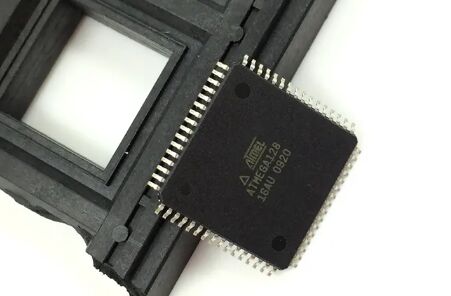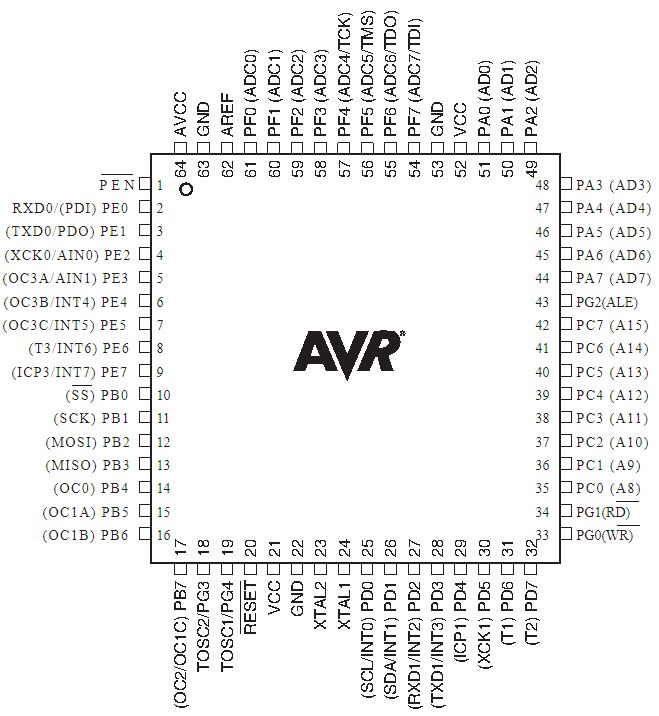By ATMEGA 289
ATmega128L is an 8-bit series of microcontrollers from ATMEL. It is the highest configuration of ATMEL's 8-bit series of microcontrollers. Due to its excellent performance in stability, it has been widely used in the market, such as automobile and tram management. , access control systems, remote controls, smart homes, and electricity meters and other fields.
Atmega128A is an AVR 8-bit microprocessor chip that adopts an advanced RISC structure and an AVR core. It has a 16MHz operating frequency and an operating voltage of 2.7-5.5V.

Ⅰ.ATMEL company introduction
The world's leading semiconductor manufacturing company for high performance, low power consumption, non-volatile memory and digital integrated circuits.
In 1997, due to market demand, ATMEL launched a new configuration reduced instruction set RISC microcontroller high-speed 8-bit microcontroller, referred to as AVR.
It is widely used in various fields such as computer peripherals, industrial real-time control, instrumentation, communication equipment, and household appliances.
Ⅱ.Features of ATmega128L
•High-performance, Low-power Atmel&AVR&8-bit Microcontroller
•Advanced RisC Architecture
-133 Powerful Instructions - Most Single Clock Cycle Execution
-32 x 8 General Purpose Working Registers + Peripheral Control Registers
-Fully Static Operation
-Up to 16MIPS Throughput at 16MIHz
-On-chip 2-cycle Multiplier
•JTAG (EEE std 11491 Compliant) Interface
-Boundary-scan Capabilities According to the JTAG Standard
-Extensive On-chip Debug Support
-Programming of Flash, EEPROM, Fuses and Lock Bits through the JTAG Interface
•Peripheral Features
-Two 8-bit Timer/Counters with Separate Prescalers and Compare Modes
-Two Expanded 16-bit Timer/Counters with Separate Prescaler, Compare Mode
-Real Time Counter with Separate Oscillator
-Two 8-bit PWM Channels
-6 PWM Channels with Programmable Resolution from 2 to 16 Bits
-Output Compare Modulator
-8-channel.10-bit ADC
8 Single-ended Channels
7 Differential Channels
2 Differential Channels with Programmable Gain at lx, l0x, or 200x
-Byte-oriented Two-wire Serial Interface
-Dual Programmable Serial USARTs
-Master/Slave SPI Serial Interface
-Programmable Watchdog Timer with On-chip Oscillator
-On-chip Analog Comparator
•High Endurance Non-volatile Memory segments
-128Kbytes of In-System Self-programmable Flash program memory
-4Kbvtes EEPROM
-4Kbvtes Internal SRAN
-Write/Erase cycles: 10.000 Flash/100.000 EEPROM
-Optional Boot Code Section with Independent Lock BitsIn
In-System Programming by On-chip Boot Program
True Read-While-Write Operation
-Up to 64Kbytes Optional External Memory Space
-Programming Lock for Software Security
-SPI Interface for In-System Programming
•Special Microcontroller Features
-Power-on Reset and Programmable Brown-out Detection
-Internal Calibrated RC Oscillator
-External and Internal Interrupt Sources
-Six Sleep Modes: Idle, ADC Noise Reduction, Power-save, Power-down, Standby, and Extended Standby
-Software Selectable Clock Frequenc
-ATmegal03 Compatibility Mode Selected by a Fuse
-Global Pull-up Disable
•I/O and Packages
-53 Programmable I/O Lines
-64-lead TQFP and 64-pad QFN/MLF
•Operating Voltages
-2.7-5.5V ATmega128L
-4.5-5.5V ATmega128
Ⅲ.Main specifications of ATmega128L
1.Processor architecture: ATmega128L adopts Harvard structure RISC architecture.
2.Flash memory: ATmega128L has 128KB of built-in flash memory for storing user programs.
3.EEPROM: ATmega128L also has 4KB of EEPROM (electrically erasable programmable read-only memory) for storing non-volatile data.
4.Static Random Access Memory (SRAM): It is equipped with 4KB of SRAM for data storage and temporary variables.
5.Bit width: It is an 8-bit microcontroller, which means that its data processing unit is 8-bit.
6.GPIO pins: ATmega128L has multiple general-purpose input and output (GPIO) pins that can be used to connect external devices and sensors.
7.Timers/Counters: ATmega128L integrates multiple timers/counters for generating precise time delays and performing timing operations.
8.Communication interface: It supports a variety of communication interfaces, including UART (serial communication), SPI (serial peripheral interface) and I2C (bidirectional serial bus).
9. Analog to Digital Converter (ADC): It has a multi-channel 10-bit ADC that can be used to measure analog signals such as sensor outputs.
10.Peripherals: ATmega128L also includes other peripherals, such as PWM (Pulse Width Modulation) output, timers, comparators, etc., which can be used in various application fields.
11.Low power consumption mode: Supports multiple low power consumption modes, which can be used to extend battery life and is suitable for portable and low power consumption applications.
Ⅳ. Pin layout diagram of ATmega128L

Ⅴ. Three levels of AVR microcontrollers
1. Low-end Tiny series microcontroller (20 pins)
•Tiny 11/12/13/15/26/28
•AT89C1051, AT89C1052
2. Mid-range (standard) AT90S series microcontroller (40 pins)
•AT90S1200/2313/8515/8535
•AT89C51
3. High-end ATmega series microcontroller (65 pins)
•ATmega8/16/32/64/128
•Storage capacity is 8/16/32/64/128KB
•ATmega8515/8535
Ⅵ.Interrupt processing of ATmega128L
1. Interrupt overview: ATmega128L supports multiple types of interrupts, including external interrupts, timer interrupts, serial port interrupts, etc. ATmega128L supports multiple types of interrupts, including external interrupts, timer interrupts, serial port interrupts, etc.
2. Interrupt vector table: Each interrupt source of ATmega128L has a unique interrupt vector, which stores the address of the interrupt service routine. When the system performs certain operations, the vector is given certain permissions. The interrupt vector table is a table that stores interrupt vector addresses and is used to associate interrupt sources with corresponding interrupt service routines.
3. Interrupt enable: Before using a specific interrupt, the interrupt source must be enabled (allow the interrupt to occur). This usually involves setting the corresponding interrupt enable bit, for example, the EIMSK register can be used for external interrupts, and the TIMSK register can be used for timer interrupts.
4. Write an interrupt service routine: An interrupt service routine is a block of code that is executed when an interrupt is triggered. Each interrupt source has a corresponding interrupt service routine. You need to write these service routines to handle interrupt events. An interrupt service routine typically saves the register state, performs the required operations, then restores the register state and returns.
Ⅶ.Application fields of ATmega128L
1. Industrial automation: ATmega128L is an industrial automation product that can be used to control industrial equipment and machines. For example: production line control, instrumentation, PLC (programmable logic controller), etc.
2. IoT devices: Due to the support of low power consumption mode, ATmega128L is suitable for IoT nodes, such as sensors, data collectors, smart home controls, etc.
3. Embedded control system: Embedded control system can be divided into automobile control unit (ECU), motor control, temperature control system, etc.
4. Electronic toys: ATmega128L can be used to develop electronic toys and entertainment equipment, such as remote control vehicles, smart toys, etc.
5. Electronic learning tool: Due to its extensive programming support and ease of use, ATmega128L is often used as a tool for learning embedded systems and microcontroller programming.
6. Medical equipment: It has application potential in medical equipment, such as medical instruments, health monitoring equipment, etc.
Ⅷ.Alternate model of ATmega128L
1.ATmega128A: This is a variant of ATmega128L with similar features, including 128KB Flash memory and 4KB SRAM, but may differ in some parameters.
2.ATmega328P: ATmega328P is a common AVR microcontroller, often used in Arduino Uno development boards. It is suitable for small embedded projects and has 32KB of Flash memory and 2KB of SRAM.
3.ATmega2560: ATmega2560 is a higher performance model with 256KB of Flash memory, 8KB of SRAM and more GPIO pins. It is typically used in applications that require more memory and peripherals.
4.ATmega32U4: ATmega32U4 is an AVR microcontroller with a USB interface, usually used in projects that require USB connectivity, such as keyboards, mice, and game controllers.
5.ATmega256RFR2: If wireless communication function is required, ATmega256RFR2 is a microcontroller with integrated 2.4GHz Zigbee wireless communication.
Frequently Asked Questions
1.What low power consumption modes does ATmega128L support?
The low-power modes supported by ATmega128L include: Idle mode, Power-save ADC mode, Power-down mode, Standby mode, Power-save mode, and Extended Standby mode.
2.How to configure and control the pins of ATmega128L?
The process of ATmega128L configuring and controlling pins: Determine pin definition-pin mode-pin interrupt-pin peripheral function-pin status reading-pin status change-pin pull-up and pull-down-pin multiplexing - Interrupt handling - ensuring timing and electrical characteristics
3.What is the function of ATmega128?
ATmega128 is an AVR, 8-bit low-power microcontroller with a 64-pin interface based on RISC architecture. It is mainly used in embedded systems and industrial automation.